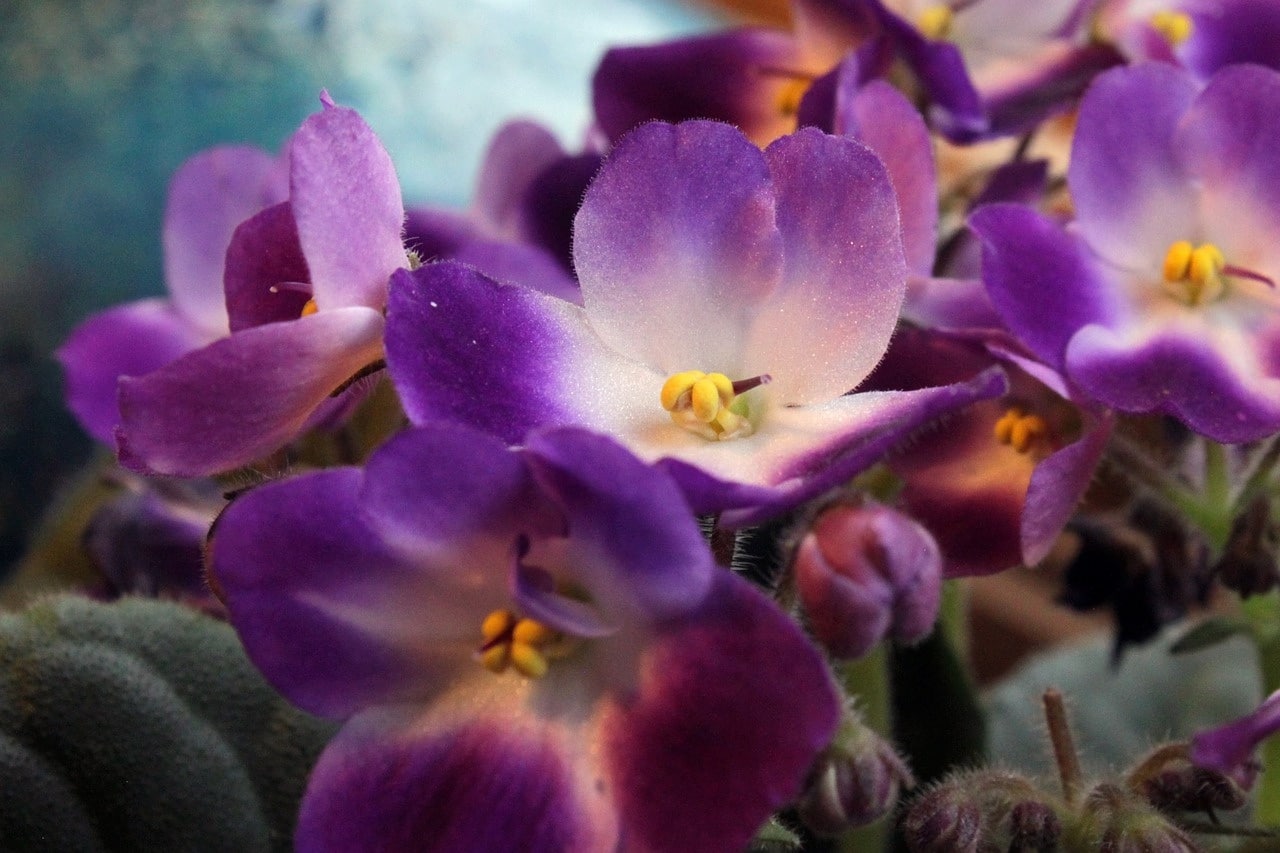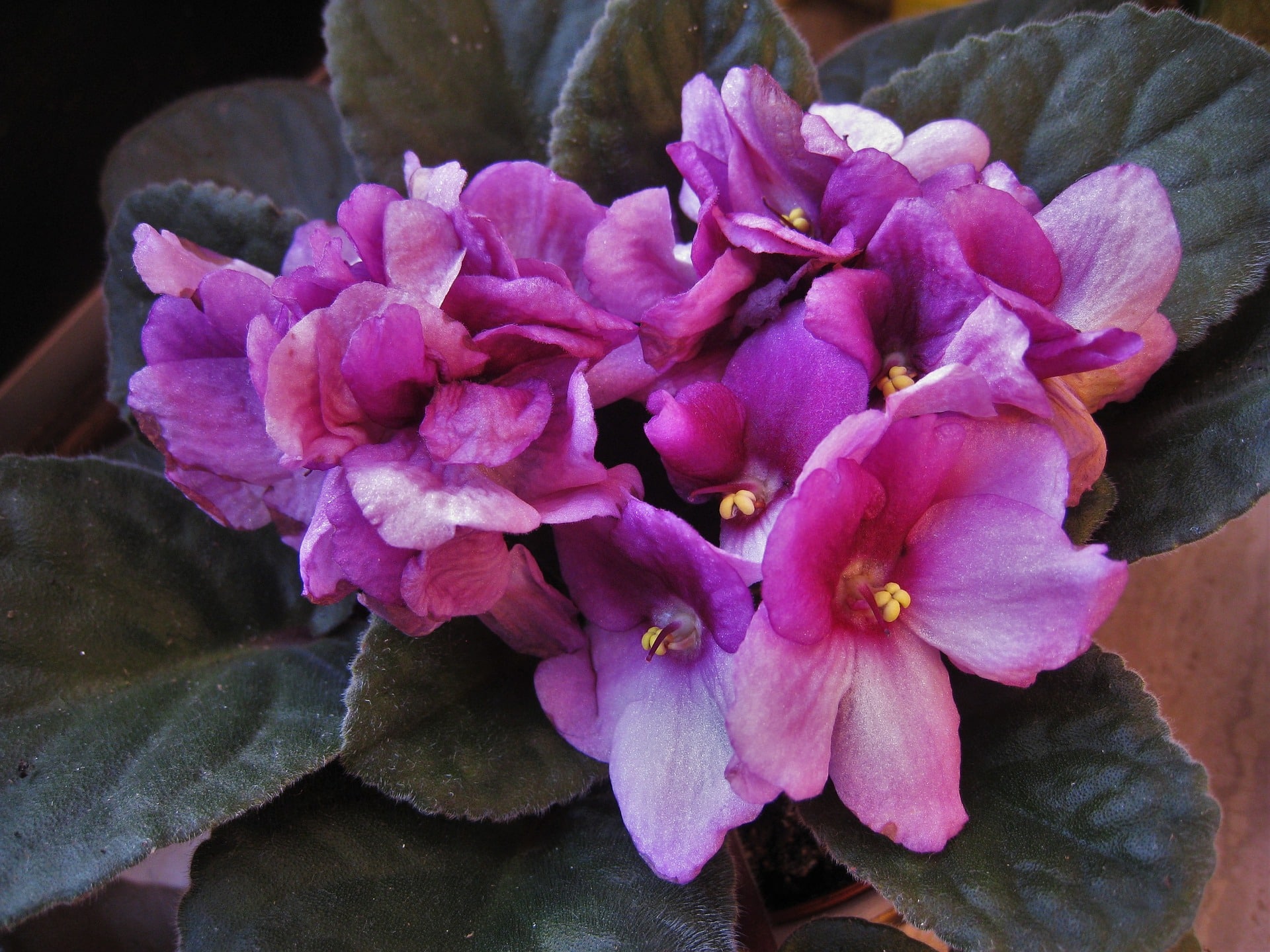African Violets Care and Feeding | Grow Healthy African Violets
Wondering how to grow and care for African violets? Our expert answers to questions relating to watering, fertilizing, repotting, and more are here to help.

Coffee By Design | Portland, Maine
Photo Credit : Katherine KeenanWhen Baron Walter von Saint Paul first brought a flowering plant he called the Usambara violet from East Africa to Germany in 1894, little did he know how many people would fall passionately in love with the African violet. Here are some of the most frequently asked questions about African violet care, along with prize-winning violet grower Jessie Crisafulli’s best advice. Her methods have produced a houseful of continuously blooming African violets, many of which sport blue ribbons won at flower shows.

Photo Credit : Pixabay
African Violets Care & Feeding
What window exposure is best for African violets? African violets should grow well in any window with good bright light, not shaded by a porch or trees. In south-facing windows, protect violets from hot sun in summer with sheer curtains or blinds. African violets do well in a south window in the winter. For east and west windows, check to see that plants do not get too warm when the sun is in that area. North windows will provide sufficient light to bloom most of the year. Keep plants close to the window for maximum light. An African violet on a table in the middle of a room may look pretty, but may not receive sufficient light to keep blooming.
LEARN MORE: Sun-Loving Houseplants | 5 Windowsill Choices
What about fluorescent light? If you do not have bright window light, then fluorescent fixtures are the answer. I use four-foot fixtures with two cool white bulbs in each. I have used one warm white and one cool white bulb in a fixture with good results. Special plant bulbs, called “grow lights,” also produce an attractive plant. The optimum distance from pot to light is 8 to 12 inches.
How often should you water African violets? “How often to water African violets?” is perhaps the most pondered African violet dilemma. The best guide is to feel the top of the soil: if it is dry to the touch, then it is time to water. African violets should be allowed to dry out between each watering for best results. Overwatering can kill a plant. The fine roots of an African violet need air, which cannot penetrate a soggy wet soil mass. Once you’ve mastered how to water African violets, half of your work is done.
Should I water African violets from the top or bottom? Either is fine. It is important not to use cold water; lukewarm or warm is preferred. If you water from the top, be careful not to get water on the leaves when the plant is in the sun; this is to avoid leaf spots. If you water from the bottom, the excess water should be discarded after the plant has taken up all it needs. Do not allow an African violet to sit in water indefinitely.
[text_ad]
What size pot is best for African violets? Overpotting will delay bloom. The usual recommendation is that the pot diameter should be one-third the spread of the leaf span. For example. if the plant’s leaves measure 9 inches from one leaf tip to the opposite leaf tip, use a 3-inch pot. Violets bloom best when they are potbound.
Which is better, a clay or plastic pot? Either is suitable. Plastic pots can be kept cleaner and will hold moisture longer, and are what I use for violets. Clay pots allow the air to penetrate to the roots, which is beneficial. but they dry out faster. I use clay for succulents and cacti. Salts may build up on clay pots, rotting violet leaves resting on the top rim. Protect the leaf stems by using a folded strip of aluminum foil to cover the top rim of a clay pot.
What’s the best fertilizer for African violets? Any reputable fertilizer is good. I like to use a water-soluble fertilizer. A balanced fertilizer with equal parts of nitrogen (first number), phosphorus (second number), and potash (last number), such as 18-18-18, has produced good show plants for me. If you are not getting good bloom try a fertilizer with a higher middle number, which will contain more phosphorus, such as 15-30-15
Should you withhold fertilizer when the African violet is in bloom? In my opinion this is poor practice. African violets need food when producing blossoms, and since the plant ideally should bloom continuously. It would severely deprive the plant if fertilizer were withheld.

Photo Credit : Pixabay
What soil mix should I use? I use a mixture of two parts sterilized soil, one part coarse perlite, and one part coarse vermiculite. Any purchased sterilized soil can be used. Perlite and vermiculite help keep the soil loose and porous.
The lower leaves turn soggy — should I take them off? It is a good practice to remove all African violet leaves that have started to decay. It is a natural process for older leaves to die off. They will be replaced by new growth in the center of the plant. Any bottom leaves turning yellow or spotted should be removed.
LEARN MORE: How to Prune Houseplants
What is wrong when the soil is wet but the plant seems limp? This may be an indication that the plant has been overwatered, and possibly crown rot has set in. There is not too much that can be done. You may be able to take off a healthy leaf or two to start a new plant, but the old plant may not live if the center crown has started to rot.
How often should I repot my African violet? Repotting African violets is beneficial to the plant’s lasting health. Repot in fresh soil every year or two at most. Do not necessarily use a larger pot each time you repot.
LEARN MORE: How to Repot African Violets
What should be done with an African violet has developed a thick stem below the bottom leaves? This is usually called a neck. It can be taken care of by setting the plant deeper into the soil when you repot. Use the proper size pot, not one that is too large or too deep. If the “neck” is too high, carefully remove some of the old soil from around the violet’s roots, so it can be lowered further down into the pot. If the soil and roots are hard and compacted, and cannot be loosened, then a portion of the bottom of the root mass can be sliced off with a knife. Repot so that the lower layer of healthy green leaves rests on the soil line at the top of the pot.
Editor’s Note: This is a Yankee Classic article from January 1982. While, we are no longer able to respond to questions about African violets that are not covered within this article, you may find the answer you are seeking in the comment section below.
This post was first published in 2014 and has been updated.








After blooming and petals dry out. What it’s the best way to handle these? Let them be or trim?
Recently purchased African Violet with what looks like a lady slipper tangerine bloom. I was told it is a new variety, but did not have any product label for identity. Please help me out on this one.
Are selfwatering pots good to use
These are all I use. Do not let them dry out. Normally every week adding water is sufficient.
African violets can thrive in self-watering pots, but you will need to watch them to make sure they don’t get to wet and rot.
I have four violets that I transplanted into clay pots and used African violet soil. I keep them under florescent lights and lost my flowers. The soil is dry to the touch and I only water when it is, but I have tiny mushrooms growing now. The plants look great but I am worried about the mushrooms. I also have little flies on them. Never had them before. Please help!
My violets have developed a mildew on the blooms.
what do I do to control that?
Hi Theresa,
It sounds like your African violoets may have been given too much water. Allow the soil to dry out completely before watering.
Hi Helen,
Mushrooms are a new one for us. You might want to try changing the soil again. You can find more information on how to do that here: http://www.yankeemagazine.com/article/home-3/how-to-repot-an-african-violet
My African violets blooms are drooping and becoming weak..should I let them fall off or trim off. And do I trim just the blossom or down to the stem
Hi Kristin,
Once the blooms start to die, it is best to pinch the stem off. Be careful not to disturb and new buds that are making their way up.
My violets are growing so beautifully on my windows sill. I think it helps to talk to them a bit 🙂
My VIOLETS DO very well in a room with a skylight until it gets hot where I live 100% or more I use air condoning but the leaves really droop I don’t have another place to put them house is mostly shaded help if u can?
I have had my plant for a year. It is not blooming but I have lots of new leaf growth. Why is it not blooming? It is in the kitchen window, south facing, some protection from porch awning, I water from the bottom when dry. How do I get it to bloom again?
Same thing happened to me
I just watched a movie on TV that showed a persons planting an African Violet in the ground on a grave. I assumed that this type violet is strictly a potted plant….am I correct?
I’ve had various A.V. for years and not long ago I found one I thought was unique. The leaf edges were white and the flowers were white smallish with pale green edges. When I needed to grow another of these I took a leaf, rooted it and later had three plants from this leaf. One plant developed like the original, but the other two were different. One was a pale lavender larger petals and the second was smaller petals pale lavender with a hint of green around the flower petal edges. Does anyone know why?
my violet has brown spots on the upper side of the plant and some of the leaves are turning yellow. What am I doing wrong.
I had several african violets that never bloomed. I had a house sitter while we were away and when I came home my plants were thriving. I asked what she did to them and she said she talked to them! I have tried it and as silly as it sounds it really works. Just a little TLC is all it takes.
What do you say to the African violet?
I have a dish garden that has a African violet in it and I need to transplant the violet. It is 1yr old and the other plants are getting larger and it is hard to water and not over water the violet. How do handle the African violet and not touch the leaves? I have been told if you touch the leaves they will die. Your help would be appreciated.
I handle my AVs with no problems, just don’t get the leaves wet.
Yes, just like Patrice said I have handled my plants gently and they seem to be hardier than you’d think . Some say to have the plant dry out a little first so that the leaves aren’t real “stiff’ or “turgid” ( lending them maybe to be more brittle ). But it is a sure thing if you drop water on the leaves, wipe off immediately as those leaves will die. I found this out the hard way !
Just purchased an African Violet with bloom resembling a Lady Slipper, tangerine in color. Was told by the merchant it is a new variety, but I did not get its name.
Can you use miracle Grow pure and feed plant food to feed African Violet
I have been watering continuous flowering 30+ year old plants with Miracle grow plant liquid with 10 drops to qone quart of warm water for over a year now every week.
My AFV are at least 47 years old (yes I said 47) and they bloom almost year round,as they are now, and I am amazed ALL the time!!
GOOD HEAVENS ! An astonishing 47 yrs !? Pray tell, how do you do it ? Can you please tell us in a nut shell what your best advice is for growing such long living plants ?
How often do you fertilize African violet?
Do I feed African Violets year round?
I wanted to tell everyone who has never done it that you CAN start a new plant from a healthy leaf ! My story is : I was given a beautiful HUGE 40 yr old African Violet from an older lady. It measured about a foot across. But try as I might I had it all but killed off in 10 mos ! I was DESPERATE to save it and sought help at a local greenhouse. They fixed me up with a “seed and cutting” mixture, plus a powder for “rooting”. I selected 8 of the healthiest leaves, cut their stems at a 45 degree angle, dusted the cut end with the powder and inserted them in the special soil. I’ve kept them moist for 3 mos now and have little baby leaves sprouting up on all ! At first I was even terrified to cut the 8 leaves off, but I got brave and did because the plant was surely doomed the way it was going. I am getting ready to put each one into an African Violet potting soil now. I am thrilled I may get to save this old plant after all !!
I know nothing about AV and I had one that bloomed all the time. But I let my friend transplanted it and I believe I watered it to death or the soil was not the kind it needed. Never knew it needed to dry out. I have a baby that my ill mother-in-law left and I am trying to keep it alive. It is very tiny. The soil is like a rock and I’ve tried to get it softer by putting a lot of water in the dish to soften the soil. Now I see that is wrong. I have gotten a few tips from reading all the replies. Thanks. Still don’t understand the size of the leaf to the pot size but maybe I can get that help somewhere else.
I love African violets. But they can be challenging.
Thanks for the info
I have an AV that mom gave me after returning from the Viet Nam War. That was over 50 years ago and it’s still blossoming.
What causes some of the leaves to get almost white, still blooming and otherwise
look healthy.
It sounds like a lack of nitrogen in you fertilizer. Try a recommended half strength fish emulsion with the watering. If that’s the cause it should start to green up, especially new growth. Sometimes too much sun will bleach the leaves as well.
A lot of great advice here, I am expecting an African violet from a customer of mine. Just trying to get some hints, it will live in the office and everyone will see it. I don’t want to kill it.
Why is it essential to repot the African Violet? I ask this because my husband has an electric green thumb – he really is great with plants, and his African Violets that he has had for decades completely thrive in the same pot. I am curious what the benefits/drawbacks are? (I have a brown thumb, obviously.) What he does is add new soil throughout the year sporadically as he feels necessary. He says they grow used to their home and the way the soil is and doesn’t want to disrupt them.
Reading up on them seems like this wouldn’t be the case so I am thoroughly confused. Any thoughts appreciated!
The outer edges of the leaves are turning brown, what may be causing this?
My beautiful AVs are all dying in the center. What should I do? They were growing and flowering then I noticed all the centers were dying.
It sounds like overwatering with resultant rot.
My AV have long skinny things growing from them, what are these things. Thanks
I am the proud Mother of 8 AV. I started my journey after my husband brought me one for Mothers’ Day. I put it under two grow lights…a year later, it won a purple ribbon at our fair. I am hooked. I found 7 AF on sale at Walmart and scooped them up….they were in self watering plastic containers. However, once a week, right after watering, I remove them for several days until I feel it is time for them to have a drink. Yes!!! talking to them helps. They are my daughters and they know it. I think the Carbon Dioxide for your breath helps too. :)))
How much water should be given to AVs at each watering ?